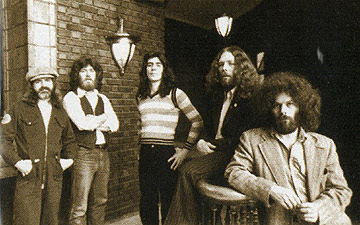
Garolou, circa 1980 : Michel Deguire, Reginald Guay,
Gaston Gagnon, Michel Lalonde, Marc Lalonde
 Garolou, circa 1980 : Michel Deguire, Reginald Guay, Gaston Gagnon, Michel Lalonde, Marc Lalonde |
| La formation Garolou (autrefois nommée Lougarou) fut établie autour du noyau des frères Lalonde, Marc et Michel. Deux nomades natifs d'Ontario, ils se retrouvent ensemble dans une troupe de théâtre à l'Ile-du-Prince-Edouard en 1974. Dans peu de temps, ils entrent en contact avec des musiciens de grand calibre, notamment le guitariste George Antoniak et le claviériste Steven Naylor. L'arrivée du batteur Michel "Stan" Deguire complète la première édition du groupe.
Lougarou déménage alors aux Laurentides et se met aussitôt à bâtir leur répertoire musical rock avec des touches progressives. Ils puisent en grande partie d'une source peu habituelle: des archives de chansons traditionnelles franco-canadiennes de musicologues tel le Père Anselme Chiasson. Bien que les foules étaient prêts à accueillir le groupe, les compagnies de disques ne mordaient pas à leur son. C'est ainsi que Nick Blagona, ingénieur et propriétaire du Studio de Morin Heights, au Québec, leur propose d'enregistrer un album en échange de redevances lorsque le groupe réussit à sécuriser un contrat de disque avec les rubans maîtresses. Naylor et Antoniak retournent à l'Ile-du-Prince-Édouard avant le deuxième album. Ils seraient remplacés par le guitariste Gilles Beaudoin et le claviériste Réginald Guay. (Beaudoin quitteraient le groupe avant le troisième album, et serait remplacé par Gaston Gagnon.) Bien que le changement de personnel était déjà chose commune, un changement de nom n'y était pas. Suite à une poursuite judiciaire de la part d'une troupe de danse folklorique ayant le même nom, le groupe modifirait son titre à Garolou ( "gare aux loups" ). Les albums enregistrés au nouveau nom de groupe ne serviraient qu'à attirer davantage d'auditeurs. En 1981, il participerait à la tournée "Québec Rock" d'Offenbach, côtoyant le musicien cajun Zachary Richard et le chanteur brittanique Joe Cocker. Après un succès prolongé en modernisant la musique traditionnelle, le groupe tente sa chance à la composition pour l'album "Centre-ville" en 1983. L'album ne se vend pas aussi bien que les albums précédents, et le groupe se dissout. Une tournée lors des années '90 produit un album en spectacle, suivi d'un nouvel album studio n'ayant que des chansons traditionnelles, interprétées d'une façon encore plus moderne qu'auparavant. |
Garolou (or Lougarou, as they were initially called) developed around the nucleus of the Lalonde brothers, Marc and Michel. Native Ontarians, the nomads reunited in 1974, as part of a theater troupe in Prince Edward Island. They soon found themselves in contact with first-rate musicians from the East Coast, notably guitarist George Antoniak and keyboardist Steven Naylor.
With the addition of drummer Michel "Stan" Deguire, the first line-up moved to the Laurentians, and quickly set to the task of building up a repertoire of valid rock music with progressive overtones. They found their repertoire from an unlikely source: archives of French-Canadian traditional folk music from noted musicologists such as Father Anselme Chiasson. Although crowds were receptive to their brand of traditional rock music, record company executives were not forthcoming. In a gesture of faith, Le Studio in Morin Heights, Quebec, opened their doors to the group during off-hours, with the group owing nothing until they secured a recording contract with the finished masters. Antoniak and Naylor would leave the group soon after their first album, to be replaced with guitarist Gilles Beaudoin and keyboardist Réginald Guay. (Beaudoin would leave before the third album, in turn replaced by Gaston Gagnon.) Although lineup changes are common, name changes are less so: faced with a lawsuit by a folk dance troupe with a similar title, the revitalized group settled on a replacement name. Garolou ("beware of the wolves") seemed to mock the plaintiffs (whose name shared the description of "werewolves" with the original band moniker) while preserving a thematic link. Other albums were soon to follow, only serving to solidify the group's popularity. By the early '80s, they would be touring with artists such as Offenbach, Zachary Richard and Joe Cocker. After prolonged success while modernizing folkloric songs, the album "Centre-ville" in 1983 showcases the band's own compositions. Album sales pale in comparison to the rest of their catalogue, and the group decides to disband. A reunion tour in the '90s produces a live album, and paves the way for a new studio album, comprised solely of traditional songs with modern arrangements. |
|||